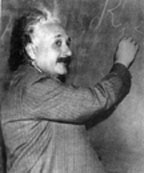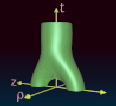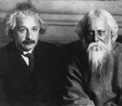| The purpose of this class:
| This class will provide an overview of the theory of general relativity,
Einstein's theory of relativistic gravity, as well as some basic applications, including
at least the solar-system tests of gravitational theories,some of the more interesting properties of
black holes and gravitational waves, along with some surveys of
cosmology.
This class will not completely prepare you for research
in this area:
it will be an overview with insufficient depth for that purpose.
However, that is more likely than not exactly what you wanted anyway.

|
|
| The first third to half of the course will
focus primarily on the basic structure of the theory, with relevant physical
motivation and insight thrown
in along the way, and also provide a reasonable introduction to the needed mathematics.
You do NOT need to already know more physics and mathematics than is described in the
Prerequisite section just below. The major applications will come after that, although
perhaps some discussion of motions around spherical stars, and weak gravitational waves will come
in the earlier sections.
|
| |
|
|
Prerequisites:
| I assume you have a good foundation in standard undergraduate physics:
classical mechanics, electromagnetism, and the usual junior-level special relativity. Also you should have a
mathematics background in calculus, differential equations, and linear algebra.
The mathematics of general relativity is
differential geometry, but I am not assuming you have had
any studies on that before: we will spend a good fraction of the first
portion of the course learning the relevant differential geometry.
An extended/advanced course in special relativity is NOT necessary. Only the basic ideas of
spacetime, 4-vectors, Minkowski diagrams, etc. are needed from special relativity; our time will
mostly be concerned with questions involving gravitational fields in 4-dimensional spacetime.
|
As already stated,
I will actually be following
handouts of my own creation, presented as pdf-files on this website, which should be read, at least more or less, in the order listed below.
Handouts to supplement the texts: parts of the course will
follow these closely.
They are Acrobat-readable (*.pdf) files that
you should print out, at appropriate times during the course of the class.
- Introductory comments about tidal gravitational forces,
and geometry, 11 pages.
- A brief review of special relativity,
along with some notational conventions, 25 pages, somewhat revised.
- Some notes on the Lorentz group and its subgroup,
rotations in 3-space 28 pages.
- A useful summary of the
Lorentz transformations of several useful physical quantities, 6 pages.
- While I have discussed some notations for vector spaces and matrices in the review of special relativity, it is hoped that
a complete summary of such things, including comments about the Levi-Civita symbol and determinants of matrices is given here: Introduction and
Conventions on Vectors,
Tensors, and Matrices, 23 pages, revised 3 Febr., 2016.
- In some sense all of the above handouts have dealt with review, or physical motivation. At this
point we begin considering the mathematical needs for general relativity!
Tangent Vectors and
Differential Forms over Manifolds 33 pages.
- Important notes on
Covariant Derivatives and Curvature; 73 pages. revised only slightly, 23 Febr., 2016.
This contains the physical interpretations for the ideas named in the title, and is extremely important.
It also has the clearest discussion of (non-holonomic) tetrad basis sets, best for physical interpretations of components of vectors.
- Some useful notes on ways to view the curvature tensor, and its parts.
- Various very recent papers concerning the January, 2016 observations by LIGO of gravitational waves
emitted as two black holes merged:
From here on, the handouts consider various specific applications to physical systems.
- A summary of local properties of
spherically symmetric, static
spacetimes; 9 pages;
and also some notes on the Kruskal extensions.
and some figures showing light cones along radial, inward
trajectories in both Schwarzschild and Kruskal coordinates,
as well as a Maple file that can be downloaded and run,
showing radial, inward timelike trajectories in considerable detail.
- A Penrose conformal diagram for the Reissner-Nordström manifold.
- Discussion of observations
made by a uniformly accelerating observer; 15 pages.
- The Kerr metric, for
rotating stellar objects: some rather brief listings of properties
and equations; 4 pages.
- the important, original paper on rotating black holes:
Rotating Black Holes: Locally
Nonrotating frames, energy extraction, and scalar synchrotron radiation
,
by James M. Bardeen, William H. Press, and Saul A. Teukolsky,
The Astrophysical Journal, 178, 347-369 (1972).
- An invited paper on colliding(plane)
gravitational waves by Valería Ferrari, presented at the 1989 conference of the
Society for General Relativity and Gravitation (GRG), in Boulder, Colorado.
- A discussion of Lie
derivatives and Killing vectors; 15 pages
- All the notes below here concern many different opinions on the very intriguing subject of Cosmology:
- Notes on Robertson-Walker [or FLRW] Spacetimes: solutions of Einstein's equations where homogeneity and isotropy of the entire universe---on average, over some scale--- are assumed, and, further, that the matter can be modelled by a perfect
fluid with everywhere-defined flow lines. Sometimes referred to as the "concordance" model, which, perhaps, means that
this is the most well-agreed-upon model for the background space for the universe, from which perturbation theory should begin. 7 pages.
- Some background as to the controversy:
- Pedagogical discussion of
the problems concerning
horizons in FLRW Cosmologies, published
in the American Journal of Physics,, in 1993.
- Excellent review article on the 83 years of
General Relativity and Cosmology, 1999: 39 pages.
- More recent, quite brief summary, 2001---posing questions to be answered
- A brief article by George Ellis, on probable
need for using inhomogeneous cosmological, concerning "patched together" solutions, from 2008.
- An article from the Scientific American on difficulties with the idea of dark energy, 2009.
- A careful study of Inhomogeneity and the foundations of concordance cosmology, by Clarkson and Maartens, 2010, from Classical and Quantum Gravity.
- A detailed proposal, of the status, in 2008, of dark energy and alternative
explanations of the problems with the data.
- A more detailed list of references for some of the disparate (current) Work on Cosmologies alternative to the FLRW (isotropic and homogeneous) model. Quite a few different groups of workers noted.
- I will make no comments here about the proposal for inflation, a process involving quantum phenomena, which many believe probably occurred "before the current era."
My reluctance concerns the fact that it needs must involve a quantum approach to gravitation, for which there are as yet no well-defined theories. However, a particular interesting article is the one
below:
A particular explicit model for inflation:
the emergent universe, 2003.

Exams and Homework Assignments: There will be two
examinations, currently scheduled for 21 March and 27 April,
but no final examination.
In addition, there will be (more or less) weekly homework assignments,
with solutions posted after they have been turned in.
The grader for
the course is (Stephen) Keith Sanders. If you wanted to speak with him, note that he usually attends class, but you could
also email him for a meeting time and place.
| Homework Assignments
| Due Date
| Homework Solutions
|
| HW #1,
| due 27 Jan.
|
Solutions for HW #1
|
| HW #2, extended
| due 3 Febr.
|
Solutions for HW #2
|
| HW #3,
| due (Monday) 15 February.
|
Solutions for HW #3
|
| HW #4,
| due (Monday) 22 February.
|
Solutions for HW #4
|
| HW #5,
| due (Wednesday) 2 March.
|
Solutions for HW #5
|
| HW #6,
| due (Wednesday) 9 March.
|
Solutions for HW #6
|
An Exam on Monday, 21 March, 2016
You may bring any personally-written material with you, or my handouts for this class.
| Solutions
are available here.
|
| HW #7,
| due (Monday) 28 March.
|
Solutions for HW #7
|
| HW #8,
| due (Monday) 11 April.
|
Solutions for HW #8
|
| HW #9,
| due (Wednesday) 20 April.
|
Solutions for HW #9
|
Exam 2 (Take Home) is due on Wednesday, 4 May, 2016
It is due at the beginning of class that day.
You may NOT consult with any humans other than myself;
| Solutions are here
|
--->
Usable Maple files are downloadable; they
require a right-click on the link, and then choosing "Save link as ...".
Homework assignments and Solutions are pdf-files, except when occasionally
there will be an html-file for a portion of the solutions.
Solutions will
be made available once the assignments have been turned in.
Homework is
DUE at the beginning of the class period on the due date!

There are many modern software packages to perform tensor
calculations.
I
prefer the program grtensor, which is described in more
detail in this linked webpage.
After you have a reasonably-good understanding of how the
process works, I see no reason why you shouldn't have an algebraic
computing system do the work for you.


Links to
Worldwide Relativity Information Sites
- The Albert Einstein Institute, at the
Max-Planck Institut in Potsdam, Germany.
- the most important journal in the field,
Classical and Quantum Gravity.
- Astrophysical Gravitational Wave Sources:
NASA Data Archive, and information about LISA, the projected, orbiting gravitational wave
telescope.
- Historical Exhibit on
Albert Einstein, from the American Institute of Physics.
- Very interesting discussion and
movies of both
orbiting around and falling into a vacuum, Schwarzschild
black hole. Done by Andrew Hamilton, whose main
home page
has many other interesting links about special and general relativity
and interesting things in the sky.
- Some interesting movies showing
the fact that when one uses light rays to view very-fast-moving,
3-dimensional objects they appear to rotate, were made by Leo Brewin at
Monash University in Australia. I have copied two of the movies that I liked the best, which may be
found here:
They move fast; therefore, it is most interesting if you actually slowly "drag" the play button along
while watching.
-
An
interesting history of the ideas in general relativity, beginning with Aristotle and Copernicus,
along with many further links to
biographical information on the researchers involved, can be found
at this link, created by people at St. Andrews University in Scotland.
- A year-long course on General Relativity is taught every year
at Cal. Tech. This link takes you to
the webpage for that class, created by Marc Kamionkowski.
- Finley's page of
Other Interesting Links for Relativity
- From time to time, a student asks a
question which is too complicated to fully discuss in class.
If possible I will then create a webpage with a listing of
articles appropriate to answering that question.
At the beginning of the semester there were two such listings here.
- Questions about "warp drives";
- Questions concerning
Reality and Stability of Black-Hole
Interiors
- Freely Falling, or Supported
Charges Do Not Radiate in a Gravitational Field: this does not violate the
Equivalence Principle.
This paper seems to provide a correct answer
to an old and somewhat controversial question.
Some earlier responses to this question are in
this paper.
- Questions somewhat related to the radiation of charges are those concerning
the backreaction of particles in a gravitational field. They are discussed
very carefully and rigorously in
this paper of Eric Poisson.
- Is the concept of a graviton---as a spin 2, massless object "something like"
a photon" really an idea consistent with full, nonlinear general relativity?
This paper says no, although this
is still a very controversial issue.
- deSitter and anti-deSitter
spacetimes are described in these 11 pages from Hawking and Ellis' book.
This put here since there were quite a few questions about it at the last
class, and there wasn't really time to discuss it more.
However, the new book by Griffiths and Podolsky, listed in my online list of
other books, is much more complete on this question.
- Very interesting
history of Gravity Probe B, As well, there is. a recent
review article from IOP Science
Links to Exciting Astronomy News
-
Astronomy
Picture of the day
- Index
to the complete list of their pictures.
- COBE
satellite data on cosmic microwave background
- Very interesting background primer on
Cosmology and the astronomical measurements that allow us to make inferences about it.
- The official webpage for
the LIGO observatory for gravitational waves, otherwise known as
the Laser Interferometer Gravitational Wave Observatory, built
at Livingston, LA, and Hanford, WA.

Last updated/modified: 19 January, 2016



![]()



![]()
![]()
![]()
![]()
![]()
![]()
 Click here to mail your
comments and suggestions
concerning the Homepage
Click here to mail your
comments and suggestions
concerning the Homepage to go to the Physics and Astronomy Department Home Page.
to go to the Physics and Astronomy Department Home Page.